Depot News – week ending 28-Feb-21
This week, we have plenty of news to report because DEPG member and Maybach specialist Bob Clegg and a small team comprising Martin and Neil attended at Williton last Tuesday (23-Feb) to perform checks on the Maybach MD-870 engines that are installed in our ‘Hymeks’. Both locos were started easily and ran nicely, with no issues reported.
Terry also attended to check over our Paxman-engined Class 14 D9526 and this loco was also started up and run for an hour or so, again with no issues reported.
A short video compilation is provided below:
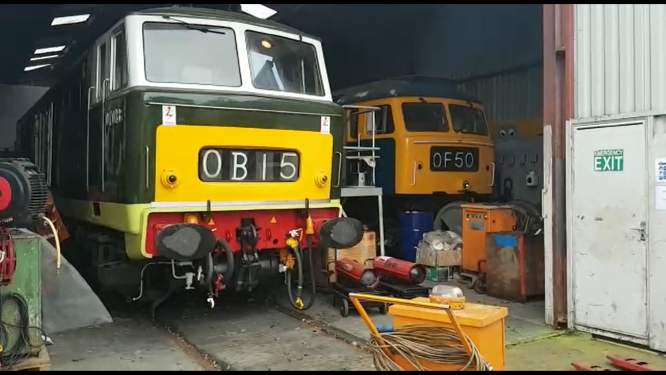
The preparation of D7018 gave an opportunity for the pre-heating to be performed using Bob Clegg’s new portable pre-heater that is connected to the loco using quick-release self-sealing hoses. The portable pre-heater allows us to get the Maybach MD870 engine warmed up to the required temperature for starting, even if the on-board pre-heater has failed. The concept has now been proved to be successful so the pipework for D7017 and D1010 will be modified at some point in future to allow the portable pre-heater to be used on all three locos. This will reduce the risks of on-board pre-heater failure that has been the cause of some locos missing their booked turns in the past.
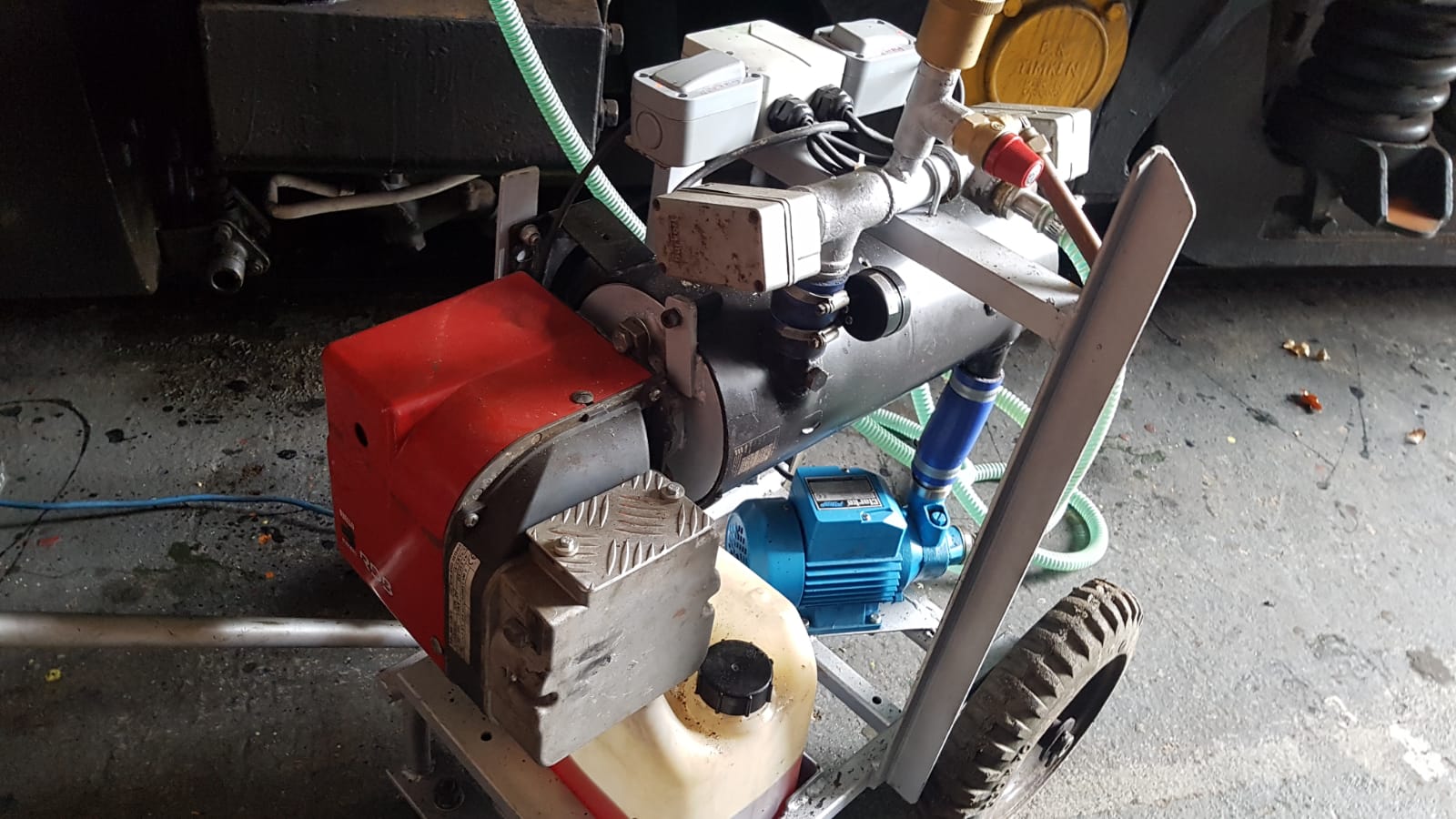
Pre-heating the engine before starting allows the engine parts to expand to a closer fit, thereby reducing the wear, noise and smoke that would otherwise accompany a cold start. It can take four or more hours of pre-heating to get the coolant up to the required 43°C before the start button becomes live and allows starting to take place. This was not a problem in BR days because locos seldom stood around idle for long enough to cool to below 43°C, but in preservation, we have to take account of this and make sure that the engines are properly looked after. NOTE: HSTs that are fitted with MTU engines also have pre-heaters.
The twin Maybach MD-655 engines of our Class 52 ‘Western’ D1010 ‘WESTERN CAMPAIGNER’ present us with a different set of challenges. The engine at ‘A’ end (currently at the north end of the loco, away from the shed) is serviceable but the cooling system suffers from leaks so the loco was drained prior to the winter as a precaution against frost damage. It will be necessary to stem the leaks and re-fill with coolant before pre-heating can be attempted. The engine at ‘B’ end (currently the south end of the loco, nearest the shed) cannot be started because the transmission has been removed from the loco (the dynastarter drives through the transmission). Both engines need lubricating and turning over by hand and this will be arranged as soon as possible, with a separate working party dedicated to the task. Meanwhile, the batteries have been charged so that there will be the capacity to start up ‘A’ engine when ready.
Also receiving attention to batteries this week was the WSR’s Andrew Barclay 0-4-0 diesel-hydraulic shunter, works number 578, ex-ROF Puriton ‘Number 1’ which these days resides at Williton yard. This loco uses a 48V electrical system and the battery charger is a lot smaller than the 110V types that are used on the mainline locos, so it is a quick and easy task by comparison. The Paxman engine of this loco will be run at the next opportunity.
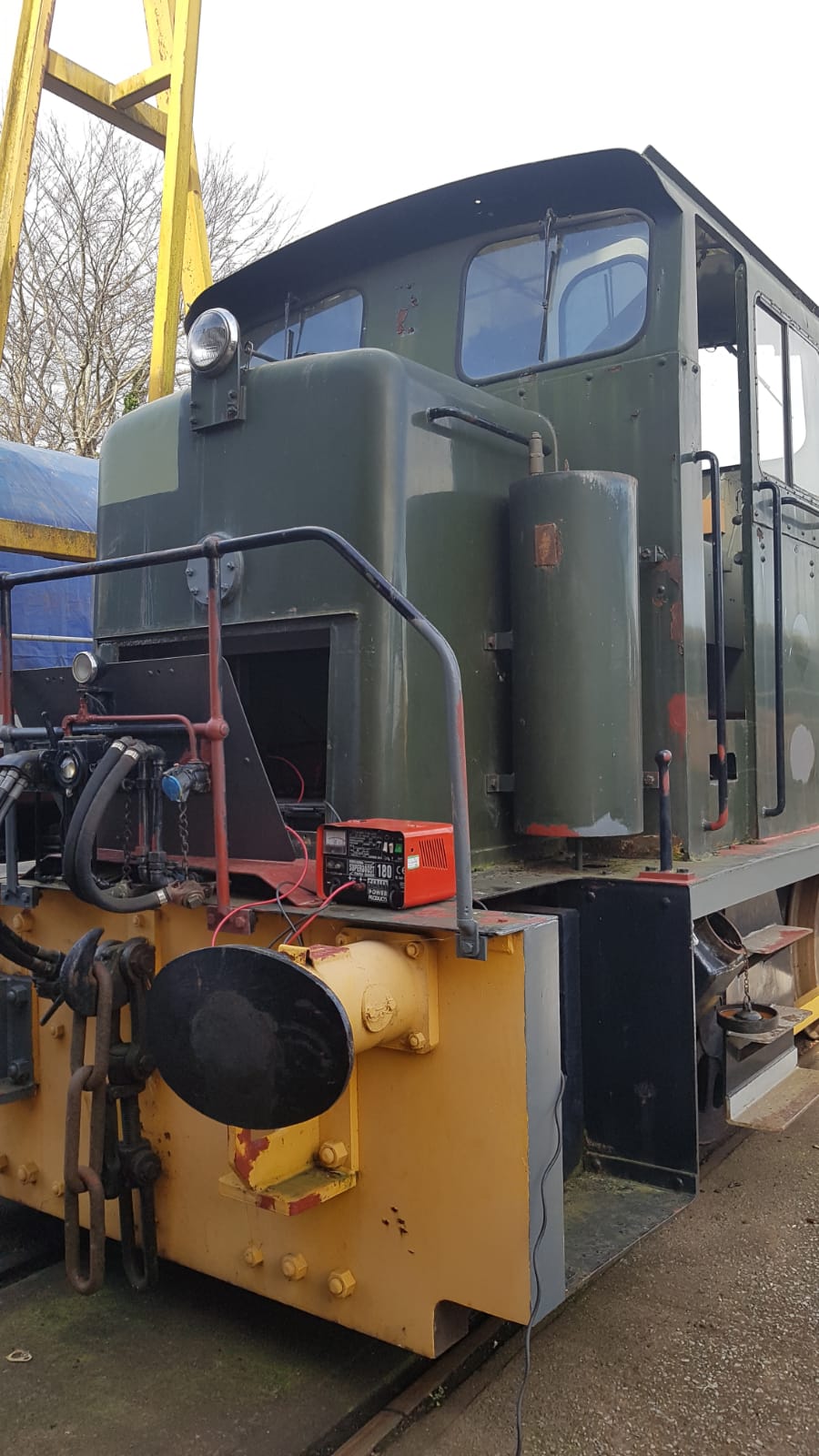
LOCO NEWS: Other than that reported above, the status of our locos remains unchanged this week, due to lockdown.
Last week, we covered the 44th anniversary of the “WESTERN REQUIEM” railtour that ran from Paddington to Aberdare, Merthyr and Treherbert at the heads of the valleys of South Wales with our very own D1010 ‘WESTERN CAMPAIGNER’ doing some of the work before disgracing herself (temporarily) by the overheating of one of her engines. As reported last week, she was removed from the railtour when she reached Cardiff and was replaced by 37 179 for the trip to the heads of the valleys, until sister loco D1023 ‘WESTERN FUSILIER’ saved the day by taking over at Pontypridd for the climb to Merthyr and the return to Paddington.
The substitution of the very grubby Class 37 made me wonder if the carriage heating was being supplied by the loco on that cold day. The question was posed in last weeks’ roundup and the following responses were received:
From DEPG founder member Clive Burrows:
“Your weekly roundup raised the question about the ability of 37179 to heat the train it took over from D1010. The Cardiff Canton and Landore Class 37 fleet included a batch of steam heat fitted locomotives that were in the series 37175-37192. You may recall the WR high speed tests carried out by a pair of Class 37s in the mid 1960’s that used D6881 & D6882, which are from this series D6875-D6892 that became 37175 to 37192. They covered a mixture of freight and passenger work in the South Wales and Bristol Divisions, taking over West Wales passenger duties from ‘Hymeks’ in 1972 as the ‘Hymeks’ were being progressively withdrawn from service.
In addition to scheduled passenger duties in West Wales, I often caught the 8-coach 16:55 Newport to Cardiff that was always hauled by a Class 37 from this series and sometimes came across them on passenger trains to Gloucester and Cheltenham. The conversion programme to fit ETH to some Class 37s (Class 37/4) resulted in the steam generators being removed from 37175-192. Canton modified several of these locomotives to use the redundant boiler water tank as an additional fuel tank, thus increasing fuel capacity from 950 gallons to 1750 gallons and enabling these locomotives to have an extended range. A yellow dot was added under the locomotive number to denote locomotives modified in this way.
The steam generator fitted locomotives were also used on a variety of freight duties. As an example, I can recall catching the 04:15 Westbury to Acton Mendip stone train from Westbury back to Chippenham when returning from an incident in the early hours of 9th June 1982 and the train being hauled by 37181 & 37187 from this series.”
And from regular contributor Neale Long:
“Interesting to read the report of the actual Western Requiem Railtour as opposed to the relief which ran a week earlier. In view of what actually happened I’m glad I travelled on the Relief and not on the actual main tour. Clearly D1010 struggled manfully to get the tour to Cardiff where inevitably, and to my mind, quite correctly she was failed. What was absolutely staggering to me was the effort BR made to rescue the tour by running D1023 light engine from Old Oak Common to Pontypridd, a simply magnificent effort to rescue the day and tour.
As regards the boiler on class 37179, she was part of a small batch of WR based boiler fitted Class 37’s used on passenger services in West Wales. Several overnight passenger trains ran throughout the year necessitating locomotives with train heat. There were workings such as
Paddington – Milford Haven / Fishguard Harbour sleepers and postal trains from Swansea to Bristol TM. Peak periods such as rugby matches at Cardiff saw these locomotives come into their own with train heating facility. The batch, I seem to recall was from 37177-37190. I venture to suggest that its appearance on the tour was of no coincidence. These would have retained an operable boiler until the
early 1980’s.”
Many thanks to both contributors for sharing their knowledge with us all.
This railtour, and others, will be covered in detail in our forthcoming booklet “D1010 – from Merehead to Minehead”.
44 YEARS AGO TODAY: Another anniversary today is the withdrawal from service of the last four remaining Class 52 ‘Westerns’ following the success of the ‘WESTERN TRIBUTE’ railtour of 26th February 1977. The last blast of the ‘Westerns’ was a 628-mile double-headed railtour from Paddington to Swansea to Plymouth and back to Paddington, and the locos allocated to the railtour were 1023 ‘WESTERN FUSILIER’ and 1013 ‘WESTERN RANGER’. Our own D1010 ‘WESTERN CAMPAIGNER’ and sister loco D1048 ‘WESTERN LADY’ were on standby as backups and actually shadowed the railtour as far as Bristol on the first leg and to Plymouth and back to Paddington on the subsequent legs. In the event, the tour went to plan and the backup locos were not needed.
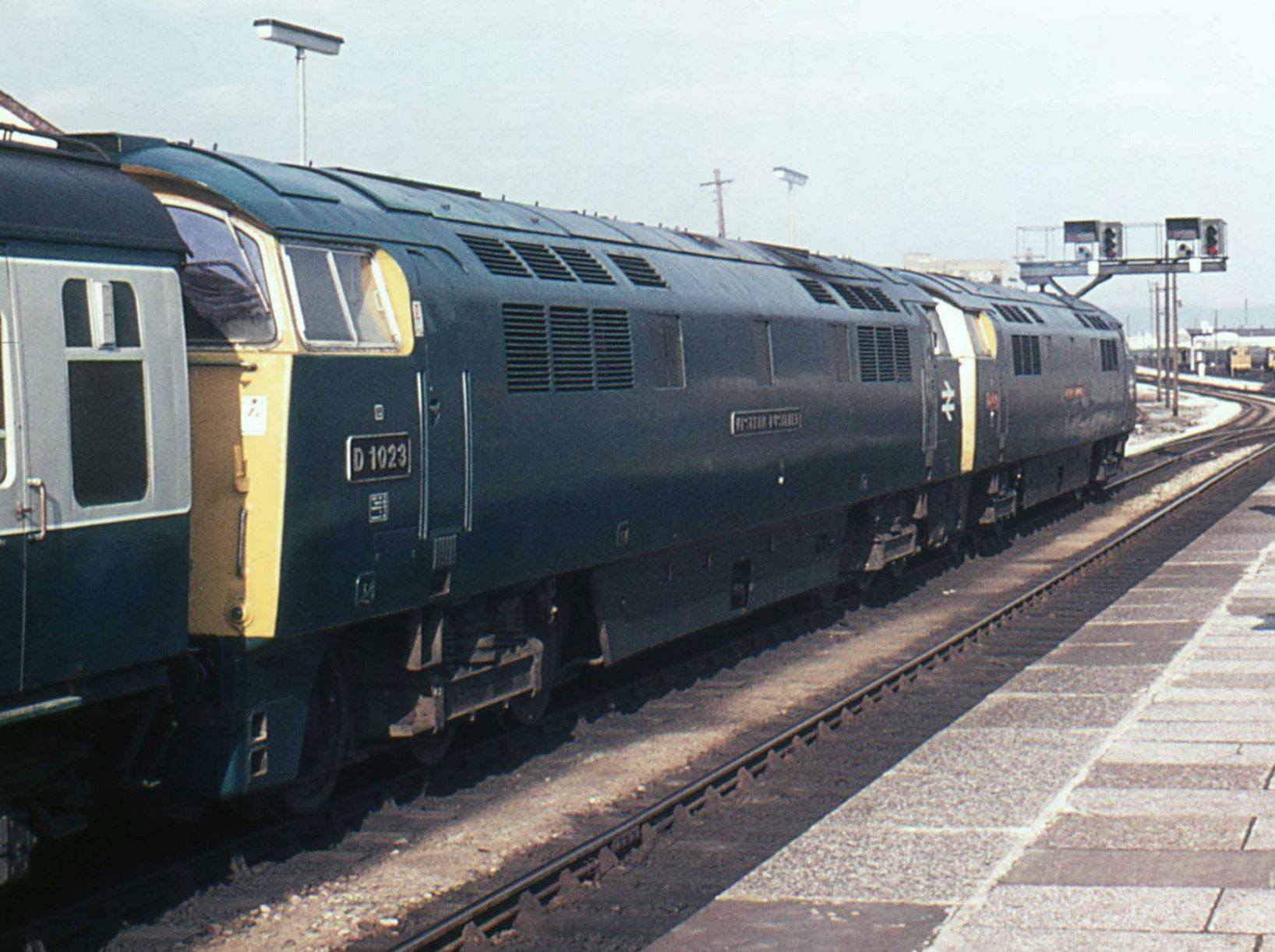
This railtour commemorated the end of the 19-year diesel-hydraulic traction era on the Western Region of BR. All four locomotives were withdrawn from service just two days later, 44 years ago to this very day.

Luckily, all four locos survive from that day to this, plus three others that were withdrawn earlier. The preserved locos are:
| Number | Name | Date withdrawn | Owners | Location |
| D1010 | WESTERN CAMPAIGNER | 28-Feb-1977 | DEPG | Williton, West Somerset Railway |
| D1013 | WESTERN RANGER | 28-Feb-1977 | Western Locomotive Association | Severn Valley Railway |
| D1015 | WESTERN CHAMPION | 13-Dec-1976 | Diesel Traction Group | Severn Valley Railway |
| D1023 | WESTERN FUSILIER | 28-Feb-1977 | National Railway Museum | NRM York |
| D1041 | WESTERN PRINCE | 23-Feb-1977 | Bury Diesel Group | East Lancashire Railway |
| D1048 | WESTERN LADY | 28-Feb-1977 | Midland Railway Centre | Butterley Derbyshire |
| D1062 | WESTERN COURIER | 22-Aug-1974 | Western locomotive Association | Severn Valley Railway |
Also surviving from the diesel-hydraulic era are two Swindon-built Class 42 ‘Warships’, four Beyer-Peacock ‘Hymeks’ and no less than 19 of the Swindon-built Class 14 ‘Teddy Bears’.
It is also important to note that diesel-hydraulic transmission is still in use on the mainline every day, being the motive power for countless numbers of second-generation multiple-unit trains such as Sprinters and TurboStars.
DEPG NEWS: The next edition of our quarterly newsletter has now been printed and is ready for mailing during this coming week. Current DEPG policy is to mail out the Newsletter on a quarterly basis because this is the most inclusive method of reaching all of our members. Some members may prefer Newsletters by email, but we cannot be sure of delivery due to spam filters and the like, so we will continue to send items by post.
A DEPG Board Meeting took place over Zoom yesterday and a synopsis will be produced as soon as possible and will be included in a future roundup.
DEPG WEBSITE: Our ONLINE SHOP IS NOW LIVE so go ahead and visit our store!
We have placed orders for our new range of coasters and mugs with high quality images covering all of our locomotive fleet – as can be seen from the photo below. We will add these to our online store as soon as we can get photographs of the different designs uploaded. We have also ordered more caps including some with the DEPG logo and we expect that everything will be available to ship from next week onwards.
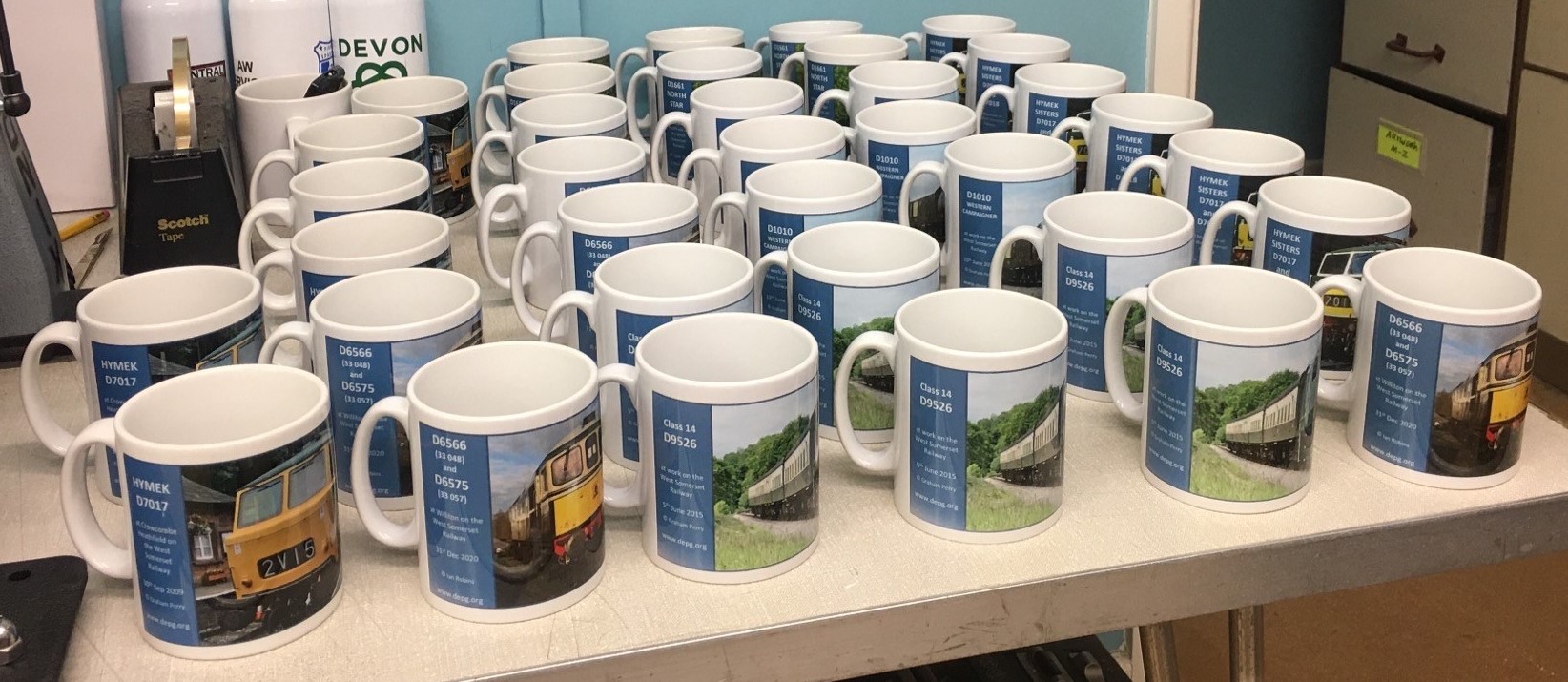
WSR NEWS: The second of the monthly Zoom meetings took place last week and the subject was the enhancement to the Safety Management System and the Compliance Management System. The meeting was very well attended and the clear message from volunteers was that we are ready and waiting for the refresher training and competence checks, so bring ’em on !
The WSR Chairman, Jonathan Jones-Pratt, once again stated the intention to restart the WSR with services top-and-tailed between Bishops Lydeard and Watchet, pending re-opening to Minehead when the track improvements have been completed, so we all need to be ready when these moments come. Again, the Zoom meetings are a great initiative by the WSR and they get ten points for doing it.